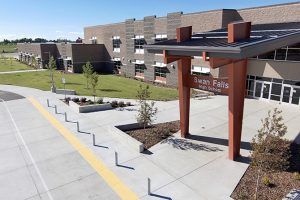Rosa T. Sheng, FAIA, LEED AP BD+C
Vice President, SmithGroup, California
Rosa T. Sheng is a Vice President at SmithGroup, serving multiple roles as Higher Education Studio Leader in Northern California and national Director of Justice, Equity, Diversity, and Inclusion. She was the first Asian American Woman to serve as AIA San Francisco President (2018) in the organization’s 136-year history.
Recognized as a designer, architect, strategist and thought leader, she is known for delivering design solutions with transformational impact in the built environment. Her innovative mindset has resulted in a variety of award-winning and internationally acclaimed projects including the aesthetically minimal, highly technical glass structures for Apple’s original high-profile retail stores — revolutionary workplace of the future in the Pixar Animation Studios, Steven P. Jobs Building — and current work to advance equitable and sustainable design solutions for institutions of higher learning in California. These include the UC Davis Teaching and Learning Complex, Lorry I. Lokey Graduate School of Business at Mills College/Northeastern, as well as STEM projects for the California State University system and community colleges to advance underrepresented students in academic persistence and future-ready resilience.
Rosa has presented her work both nationally and overseas, including “Why Equity Matters for Everyone: A New Value Proposition for Architecture” and, in 2020, “The J.E.D.I. Agenda — An Intersectional Approach to Designing a Just Future.” In 2019, Rosa was honored by Metropolis Game Changer. Additionally, she has been featured in Architect Magazine, Architectural Record, The Wall Street Journal, and The New York Times.
She is also the founder of Equity by Design [EQxD] and, through the company, has worked to address and minimize barriers in order to maximize the collective potential for success.
Robert Miller, FAIA, NCARB, MRAIC, RIBA, AACA, LEED AP
Principal, Robert Miller FAIA Architects, LLC, Washington
Robert Miller’s lifelong interests in social issues, alternative construction, renewable energy, and industrial design are reflected in his holistic approach to architecture, ranging broadly in scale from modest cabins to high-rise towers. He believes strongly that thoughtful innovation and integration are the future of successful sustainable design. He is determined that ample budgets do not exempt a project from optimizing the use of resources, nor do modest budgets relieve one of the responsibilities for excellence in architecture and sustainability.
Robert’s inventive and carefully crafted body of work includes the Pacific Rim Estate, Gosline Residence, Ballard Library, SOMA Towers, Uniqlo Shanghai, Lightbox, Tsing Tao Pearl Visitor Center, and Margalit Startup City, both New York and Israel, to mention a few. He enjoys establishing close collaborations with partner firms on large and complex projects. His creative solutions include innovative construction systems, furniture, hardware, and public art.
Recognized with over 150 national and international awards, and widely published, Robert routinely shares his expertise through lectures, university reviews, and design award juries nationally and internationally. He credits his intense curiosity to his ability to consistently find unique opportunities and a thoughtful balance between the man-made and the natural for each project’s circumstance.
In 2022, Robert established the firm of Robert Miller FAIA Architects, LLC with a mission of furthering his personal interests in projects that excel in design and innovation. Embracing the lessons and tools developed through recent years of remote work, RMFAIA invested in a fresh look at the future process of architecture. Robert embodies an unusual combination of intellectual and visceral fascinations with the place, people, and details in evolving a new era of architecture.
D. Andrew Vernooy, FAIA
D. Andrew Vernooy’s designs have influenced structures across Texas, and he has dedicated much of his time to educating the younger generation about all he has learned through his time as an architect. He has been teaching a variety of design and architecture courses since the 90s, including Structural Design, Construction, Construction Theory, Advanced Structural Systems, Urban Design, Urban Theory, Architectural Design, and Design Theory, Architecture History.
He has published three titles: Undergraduate Research in Architecture, Skins: Where Design and Technology Meet, and Austin Creeks. He has also contributed an article titled, “Crisis of Figuration in Contemporary Architecture” in The Final Decade: Architectural Issues for the 1990s and Beyond: Center Volume 7. In addition, he has written over 30 papers, articles, and reports on construction, structures, urban theory, and design.
From 1998–2000, D. Andrew Vernooy was the Associate Dean for Graduate Programs for the School of Architecture at the University of Texas. Then, from 2002–2016, he was the Dean for the College of Architecture at Texas Tech University. Throughout those times, he developed and oversaw three architecture programs: Urban and Community Design Program (UCD), Building Partnerships in Architecture Education (BPAE), and Healthcare Facility Design (HcFD). Across all three programs, the themes of community and social responsibility, collaboration, and leadership were the main focus to continue making the field of architecture a positive and engaging community for the next generation of architects and designers.
He was awarded the Texas Society of Architects Edward J. Romieniec (1999), Texas Tech University Professing Excellence, TTU (2004), and the Fellowship in the American Institute of Architects — Education (2020) for his excellent contributions to architectural education in Texas. In addition, his time at the firm Black + Vernooy helped them win six awards from 1989–2006 and his Managing Partner position at Black Atkinson Vernooy resulted in 23 awards from institutions such as Progressive Architecture, the Texas Society of Architects, and the American Institute of Architects — Austin Chapter.









